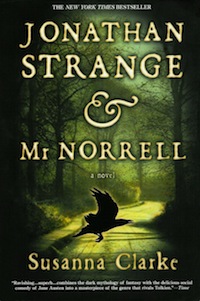Jonathan Strange & Mr Norrell by Susanna Clarke is a big, thick book. About a thousand pages, in paperback. I’ve heard several people say the size alone intimidated them. Some of those did start reading anyway, only to be put off by its other notorious feature: the footnotes.
Now, I personally enjoy a really good footnote.1 And it was clear from the first few sentences that Clarke knew what the heck she was doing. That first description of the Learned Society of York Magicians was enough to tell me not only what sort of a book this aimed to be, but also that Clarke had very likely hit her target—the period language, the gentle snark, all harder than it looks, and she’d nailed it. I was impressed before I finished the first chapter. I admit I paused a bit over the three-quarter-of-a-page footnote that’s essentially an anecdote about a pair of boots, with barely any connection to the matter at hand. Still, the anecdote was amusing, and the writing excellent. I was willing to keep reading, to see if the promise of the beginning would hold true.
It was a footnote at the end of the third chapter that sold me completely on the whole thing. It’s a digression on a digression. We are told in the main text that a very minor character, who barely appears in the rest of the novel, embroils himself in a legal case—this is a very minor character we like, the legal case is one he is happy to pursue. I suspect most readers find it endearing. I do, anyway.
The case is unusual, a matter of a statue magically endowed with speech, which then accuses someone of murder. In this alternate history England, though, where magic is very real, this is not the first time such a thing has happened. The footnote tells us about a precedent.
It has nothing to do with the main plot. It’s one of those “darlings” that beginning writers are so often advised to kill, in order that their novels can be pure, clean, efficient engines of story. We might allow Clarke telling us that Mr Honeyfoot occupied himself happily after the events of Chapter Three, because the character is so likeable and it tidies that thread up for the reader. But the 13th Century Virgin and Child on the outside of a church brought to life in the hope they can identify a murderer? No need for that.
Except it’s perfect. Even—no, especially!—the detail of how at the stone Virgin’s feet are a lion and a dragon. Except, of course, the sculptor never had seen a lion, or a dragon, so really they look more like a dog and a sheep.2 And,
Whenever some poor fellow was brought before the Virgin and Child to be examined the lion and the dragon would cease biting each other and look up like the Virgin’s strange watchdogs and the lion would bark and the dragon would bleat angrily.
The murderer is never caught. And no one bothers to unmagic the statue, so that long after anyone concerned is likely dead, if some stranger walks past the church, both Virgin and Child turn their heads and declare, “It’s not him.”
Those small details were so right. I went back and read that footnote over again. Just because.
A digression on a digression. Decoration. Filigree. But there’s more than one kind of efficiency, isn’t there. I knew before Chapter Three that this was going to be a book with lots of footnotes and that Clarke was skilled enough a writer that she must have had a very good reason for including them. But up until that moment I was running on trust. When I read that particular footnote, I knew for certain that she’d been absolutely right. And that I could know from there on out that this book was going to be awesome.
And you know what? It totally was. Footnotes and all.3
1I’ve been a fan of Jack Vance since before I was in high school. Vance occasionally annotated his fiction with equally fictional footnotes. Possibly I developed a taste for it there.
2For some really strange-looking lions drawn by people who’ve never seen one, page through a medieval bestiary or two. Or try these dragons. (Be sure not to miss the elephants in some of those dragon pictures.)
3If you’ve been put off Jonathan Strange & Mr. Norrell, by the length or by the copious footnotes, I would encourage you to give it (another) try. Seriously. It’s a wonderful book.
Ann Leckie’s first novel, Ancillary Justice, debuted from Orbit in 2013. Her short stories appear in Subterranean Magazine, Strange Horizons, and Realms of Fantasy. Her story “Hesperia and Glory” was reprinted in Science Fiction: The Best of the Year, 2007 Edition edited by Rich Horton. She is the founder of GigaNotoSaurus and lives in St. Louis, Missouri.










